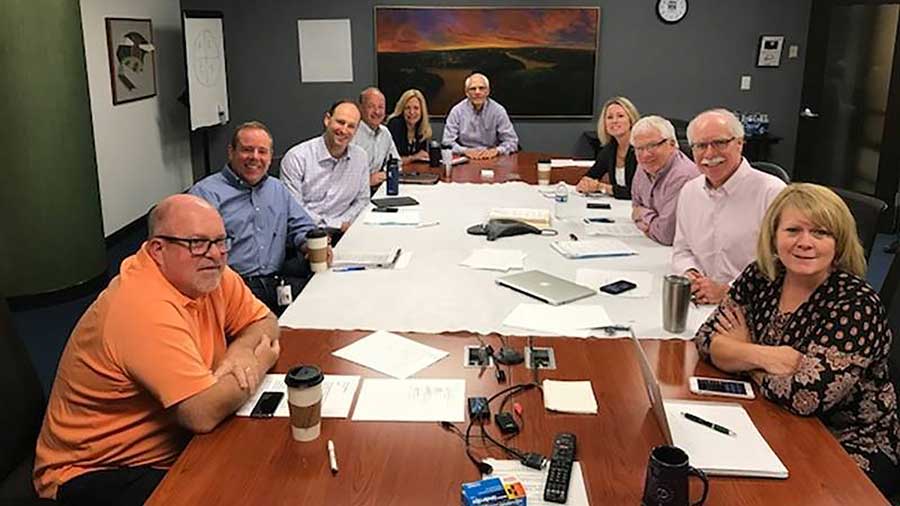Newly Retired CEO Leaves Scripps Positioned for the Future

On Aug. 8, a retiring Rich Boehne ceded his position as E.W. Scripps’ CEO and president to Adam Symson, the company’s former chief operating officer and digital chief. Boehne, who, at 61, is still very much vested in the company he has been part of for 29 years, will continue as Scripps chairman.
“I’ll still be around. I’m not out of gas, or out of ideas or in some ways losing my faculties,” Boehne said, adding that it’s simply time to give someone younger the chance — Symson is 42 — to usher the company into the next era of broadcasting. “Given all the dramatic changes and opportunity [facing broadcasting,] I thought it was a good idea to put someone in as CEO who would have a long runway ahead of him.”
Nor is Boehne in anyway averse to change. Rather, his career with Scripps corporate, which he began in 1988 as manager of investor relations, has largely been about transforming the company in pace with the larger industry.
Boehne was instrumental in Scripps’s early foray into cable television with the launch of Home & Garden TV and the subsequent acquisition of Food Network. In 2008, the year Boehne was named president and CEO, the Scripps cable networks were spun off into a separate company, Scripps Network Interactive.
Boehne championed Scripps’s exit from the newspaper business via a 2015 deal with Journal Communications that merged the companies’ holdings, then spun them off into two companies, and gave Scripps the broadcast assets, while Journal got the newspapers. As CEO, he led the build out of Scripps’ digital portfolio, which includes the news network Newsy, the humor brand Cracked and the podcast platforms Midroll and Stitcher.
Boehne spoke with B&C contributing editor Diana Marszalek about the rapidly changing broadcast business, where it’s going and how station groups can meet the challenge. An edited transcript follows.
Moving out of print and into digital, Scripps’s focus has changed dramatically since you joined the company.
The smarter way to stay on top of broadcasting and cable industry. Sign up below
We are probably only in the first or second inning of the worldwide digital business and where it goes from here. More by the day you see the digital grid [as the platform] across which most content is delivered, and that will shortly include broadcasting as it moves to new standards. It’s really a fascinating opportunity for the broadcasting industry.
What about prospects for broadcasters aside from digital?
We are seeing the resurgence of over-the-air television as one of the primary [delivery platforms]. That’s going to be one of the great stories and opportunity over the next 10 years. I tend to think its greatest value will be in delivery of news and local news, and I put the highest premium on public service. There’s a great opportunity to be part of that.
During your tenure you have reinforced engaging in public service part of Scripps company culture.
Scripps is still a very mission-focused driven organization. From me on down, whether you’d wander to an accounting department or insurance department, you don’t ever wander far from that commitment to public service. It’s what makes this place sort of click. This is a 140-year-old organization built on entrepreneurism and public service. I notice that when people talk to me, they think about Scripps and Hearst and Cox and really longtime enduring and longtime successful companies as having that genetic makeup.
How do the company’s digital brands such as Cracked and Midroll jibe with that mission?
During my tenure we have embraced and looked at how journalism is evolving and what the other platforms are. We’ve learned a lot. Our very strong commitment is to digital brands that are content-driven, which would include what’s done on the local side. Podcasting [via Midroll and Stitcher] is good media business, but it’s also a platform where long-form enterprise storytelling has migrated. And we have aggressively moved into building Newsy as a new-generation news brand. The other place you see a lot of that enterprise work is in documentary. We recognize that as one of the platforms that will be popular.
And Scripps’ commitment to being a journalism-driven company?
I am a free speech fundamentalist, absolutely a strong believer in enterprise journalism, and Scripps has always been willing to play out in the front. That won’t change here. Adam was a fabulous journalist. The transformation is far more dramatic. It’s going from a world where media is just a few very protected channels to an open wild fragmented much lower barrier-to-entry kind of environment. It’s dramatically different than the business I started in where consumers, the people who matter, had very few choices and we have a lot of control, to one where the consumers have a lot of control. There is nothing to say we can’t have success there, and we will. But it’s a new set of muscles to develop, to deliver (in a way that is) sensitive to that point of view. That’s the transformation we still have to make.
Will local TV remain relevant in that world?
Local means local, right? And what’s not local is available in a lot of different ways. Local is a real place. Geography will always drive some of the way media is packaged and presented. Over-the-air free TV is part of a mosaic, and there are an awful lot of voices out there, but it is an extremely important one especially in local markets.
